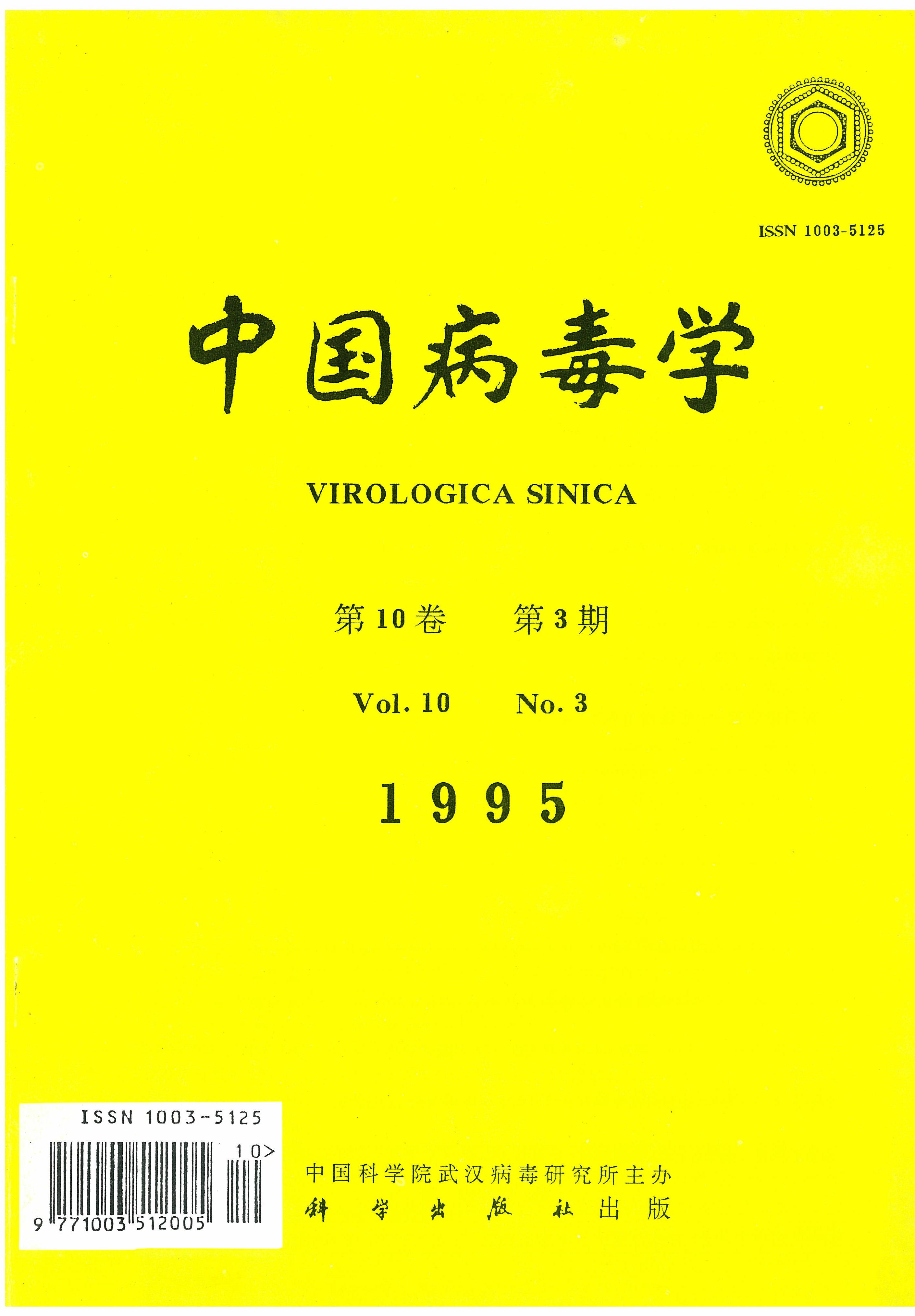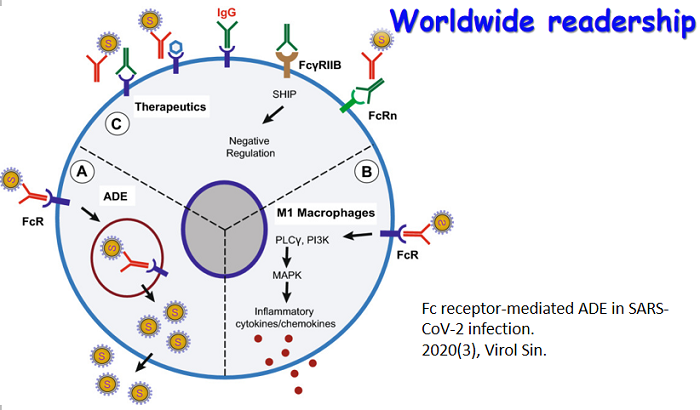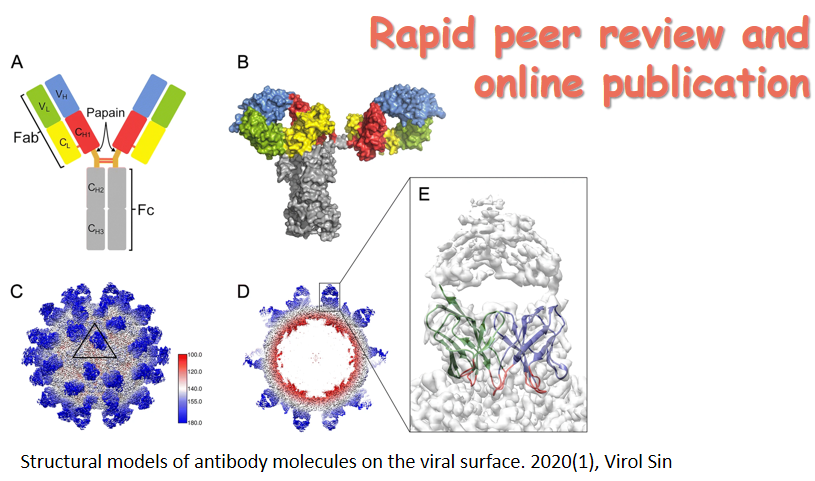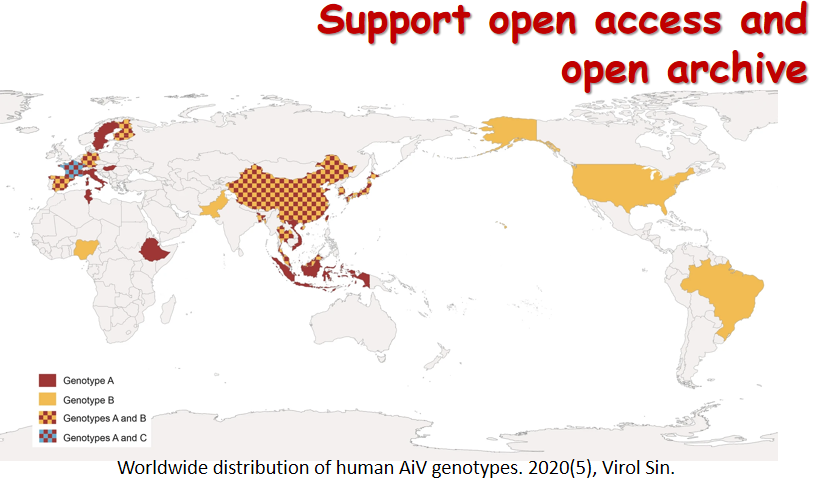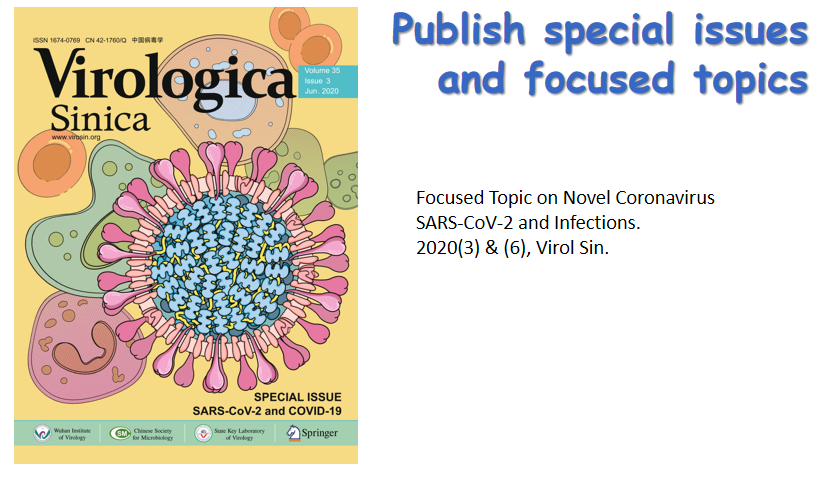Indirect immunofluorescense and Western-blot methods with seven home-made McAbs against RSV were used to distinguish RSV strains isolated in Wuhan from 1 988 to 1 992.These strains were distinguished as type A and B,further as subgruup B_1 and B_2.The RSV epidemic patterns in Wuhan were different from those of Europe and America,but were simi-lar to those of Japan.The prevalence of the two types even varied in two districts of Wuhan in the same year.It suggests the that RSV outbreaks should be regional and temporal clust-ing. No major differences in age and sex were found between the infants and young children infected with either type.
is paper reports that the HRV detection results from different ethnic minorities in In-ner Mongolia,China,146 meconium and 1 16 acute diarrhea samples were cullected from hos-Ditalized newborns and infants during winter diarrhea period in 1 993 and were examined byPAGE and McAb VP_6 ELISA.The results showed that different ethnic minority areas hadthe same predominant electropherotype,but different subtypes.HRV detected in newbornmeconium had clear genotypes of HRV group A and all belong to subgroup Ⅱ(long electro-pherotype).High HRV positive rate was found in certain area,but there was no correlationsbetween either ethnic races or geographical locations.According to epidemic investigation,lo-cal environmental hygiene level was the main infection factor of the disease.This conclusionwas further confirmed by McAb VP6 ELISA.
Immunocytochemistry and in situ hybridization were performed on the autopsy tissues of 39 fetal cases of patients with hemorrhagic fever with renal syndrome to search for viral in-clusion body(IB)and study its antigenic and nucleic acid characters.The tissues with IB were further observed by electron and immunoelectron microscope.Immunohistochemically,IB,a coarse cytoplasmic granule. was positive for anti-nucleocapsid and hemogglutinin antibody,but negative for anti-evelope protein antibody.It was found in 20 of 39 cases including 10 cases died at hypotensive phase,9 cases died at oliguric phase and 1 case died at diuretic phase of HFRS,and distributed in the renal distal convoluted and collecting tubular cells,hepatocytes mucosal and glandular epithelial cells of respiratory tract,alveolar sacs,gastroin-testinal tract,tonsil,salivary gland,pallcreas,prostate gland and pituitary gland,and seminif-erous epithelial cell of testis,etc.The similar granules with viral RNA positive were observed only in a small
In the spring of 1989,two influenza B viruses were isolated in Baoding, Hebei.The re-sults of antigenic,HA_1 gene nucleotide sequence and phylogenetic analysis of the two isolatesin comparison with other reported strains of influenza B viruses revealed that the antigenity of influenza B viruses had varied at a higher speed since 1988.The amino acid sequence ofHA_1 subunit of B/Hebei/53/89 exhibited 94.52% homology with that of B/Norway/1/85,and 97.12%with that of B/Hong Kong/20/89.The synonymous substitution analysis of theinfluenza B viruses HA_1 gene indicated that these HA_1 gene can be segregated into 5 lineagesand viruses evolved rapidly since 1988.The two viruses isolated in Hebei belonged to two lin-eages. Influenza B viruses usually become dominant at interval of two years in Japan. with e-qual frequency as influenza A viruses. However,influenza B viruses had not been reporteddominant in China. We believed that this was attributed to the methods used for the isolationof influenza B viruses:the pos
Cells of human monocyte-line U_(937)and human T-lymphocyte-line HSB_2 inoculated withHSV-1 were studied by observing the dynamics of virus titer,cellular proliferation and cy-topathogenic effect,expression of virus antigen and existing time of virus DNA. The resultsshowed that after inoculation,U_(937) cells allowed the virus to replicate only to a quite low de-gree and only for a quite short period.Twelve days after inoculation the virus was not de-tectable in the supernatans. After proliferation inhibltion and death for about 2 weeks , thecells were gradually recovered;stimulation of U(937)cells with LPS increased the virus infectiv-ity ,prolonged the infection period and promoted the formation of temporary persistent infec-tion.The results also showed that HSB_2 cells permited the virus to replicate to a higher titer,and presented an acute and cytocidal infection; stimulation of HSB_2 cells with PHA did notalter the character of the infection of the cells.
In this study,we established myocarditis model by using coxsackie type B3 inoculation.Results of the study revealed the following:5 days after inoculation,the percentage of Thylcells in the spleen of infected mice was increased,ttien it was decreased significantly on day7,15 and 2 1,L 3T4 ̄+subsets were increased on days 7,15and 2 1.Anti-cardiac antibodies inthe serum of infected mice were increased after inoculation.Virus was isolated from all thehearts of infected mice on days 3 and 5.The percentage of Dositive viral isolation were de-creased on day 7.Focal necrosis appeared in the myocardium with small lymphocytes infiltra-tion on day 5.Mvocardiac necrosis and inflammatory cell infiItration became more severe onday 7. and the ventricular cavity began to dilatate on days 1 5. Capillary and fibroblast in thenecrotic area appeared on day 2 1. The above results revcaled that T lymphocyte subsets,anti-cardiac antibodies and virus itself all may be associated with viral myocarditis.
he techniques of pathology.immunohistochemistry and ultrastructural pathology were empluyed to study the pathological changes,specific virus antigens and immune complexes in the biopsy skin tissues of 33 cases of patients with epidemic hemorrhagic fever.The specific antigens,antibodies and circulatilng immune complexes in sera of the patients were also de-tected. T he specific viral antigens were detected in 23 skin samples of the patients and im-munoglobulins,complement component C_3 were also detected in some of the samples. How-ever,for a few samples,only the virus antigens or immunoglubulins were detected.The viral antigens,antibodies and immune complexes appeared in the sera of the patients showed some relationship with the severity and the phase of illness,Furthermore,we found that there were correlations between the consumption of C_3 and the formation of immune complexes,also the degranulation of dermal mast cells and the elevation of immunoglobulin E level in sera of the patients.These suggest
PV contains two late open reading frames. T he L_2 protein encoded by L_2 ORF possesestype-specific antigenicity. To map the immunoreactive epitope of HPV 6b L_2,a L_2 expressionplasmid p6bL_2 NX was used.Plasmid p6b L_2 NXK was made by adding K pnI linker intopolylinker of p6bL_2 NXK. Unidirectional 3’ to 5’deletions were made in the HPV 6b L_2 ORFinsert of p6b L_2 NXK by using exonuclease Ⅲ and nuclease S_1.The deleted plasmids ex-pressed a set of carboxy to amino terminus truncated fusion proteins. Region containing theimmunoreactive epitope was mapped by determing retained reactivity of the deleted fusionproteins with sera in Western immunoblot assays. The related plasmids were sequuenced.The immunoreactive epiutope was located at 5481-5506 nts region,and the correspondingpepude was EPGINPTQ.
The causes of HCV infection among 97 malarla cases were studied in Hebei province.The results indicated that positive rates of anti-HCV were 71.13%for malaria cases.89.71%for those with history of plasmapheresis.64.29% for those with history of bloodtransfusion;no anti-HCV positlve was found for those with neither plasmapheresis nor bloodtransfusion. The rates were not significantly different betwecn malaria cases with history ofplasmapheresis and plasmapheresis donors at the same villages ,and it was very low amongthe malaria cases or non-malaria cases with neither plasmapheresis nor blood transfusion. Itwas showed that HCV infection of malaria cases was related to plasmaptiereses and bloodtrasfusion. By investigation the operatinq courses of taking blood,isolating plasma,and re-turn transfusion of blood cells at local plasmapheresis centers,Cross-contaimination of bloodwere found.and it was the main cause of HCV infection of malaria cases.
Two peptides of human immunodeficiency virus(HIV)type 1 and type 2 were synthe-sized by solid-phase method. An indirect enzyme-linked immunosorbent assay(ELISA)em-ploying these peptides as an antigen adsorbent was developed to detect the infections of HIV-1 and HIV-2.A comparison of our reagent with UBI reagent in detection of 46 positive serumspecimens and 94 negative control serum specimens for HIV-1 and HIV-2 showed that theconcident rate for positive was 97.8%, for negative was 100%,and the general coincidentrate was 99.3%. The results indicated that this method can be used in detection for infectionsof HIV-1 and HIV-2.
It is the first time in china that the study of an insect virus gains commercial successes.This is owlng to the development of a new formulation──emulsifiable suspension, the im-provement of tectinology and facilities,which resulted in raising production efficiency and re-ducing cost. In this paper the establishment of Heliothisarmigera colony,the large-scale rear-ing, the NPV replication,processing of viral emulsifiable suspension, product inspection andfield effectiveness are reported. The effectiveness of Heliothis viral emulsifiable suspensionwas at least equivalent to that of the recommended chemical insecticides,and superior to thatof viral wettable powder. By using 1.2-2.4×10(12)PIB/ha,the pest population was reducedby an average of 9 1.7%,while is was reduccd by an average of 83.7%when using the wet-table powder at the same dosage.
Identification , cDNA cloning and sequencing of a virus causing tobacco veinal necrosis were carried out during 1 990一1993. The obvious symptom of the infected tobacco was veinal necrosis. Aphid(Myzus persicae)was demonstrated as transmitting vector. The virus only in-fected 8 species of tobacco and Physalis floridana form solanaceae,out of 35 species from 13 families tested.It's thermal inactivation point was 50一55℃,dilution end point was 1 0(-3)-10(-4),and longevity in vitro was 48-72 hours. The virus particles were flexous rods with Sizeof 720×12nm. Scroll,pinwhell and boundle inclusion were found in cytoplasm of leaf tissues of infected tobacco. The virus could react with the antiserum of PVY ̄0 by immunoelec-trophoresis test.Purified virus had A_(280)/A_(260)ratio of 0. 82. Using a pair of primers specific to PVY ̄N,reverse transcription and PCR were performed.A specific fragment of 0. 80kb corre-sponding in size to the PVY ̄N coat protein gene was amplified. T he products of PCR were cloned in plasmid
The present study established the direct antigen coating form for indirect ELISA (DAC-FLISA)for the detection of cucumber mosaic virus(CMV)in banana tissue culture. With aproper phosphate buffer solution,i.e.0. 1mol/L phosphate buffer(pH7.2,including 1%sodium diethyldithiocarbaniate) for preparing the crude plant sap to be detected,it was possi-ble to increase the sensitivity of DAC一ELISA to a dilution of plant sap at a rate of 1/5120.Atotal of 1 287 samples of productive material for banana tissue culture were detected forCMV.2.8%of them were found to be infected with CMV.
The RHDV virion comprised six sturctural polypeptides as analysed by sodium dodecylsulfate-polyacrylamide gel electrophoresis, including A(molecular weight 60.12 kD),B(58. 27kD),C(54.74kD),D(53. 01kD),E(51. 10kD) and G(25. 90kD).The major polypep-tide A(including polypeptide B constituted about 54.7% of the total viral proteins. polypep-tide C constituted 1 7.7%, polypeptide D and E were about 22.7%and polypeptide G wereabout 4.9%. By western blotting with rabbit antiserum,polypeptides A、B、C、D、E and Gwere detected. by using monoclonal antibodies AA8-1、CG4-1 and CH3-1,all the six polypep-tides could be recognized,indicating that these polypeptides shared extensive antigenic rela-tionship.
HDV could be moved to the negative electrode by electrophoresis in the condition ofpH8.6 ,and this was confirmed by immunoelectron microscopy observation. The RHDV im-munocomplex was purified by counter immunoelectrophoresis(CIE)form liver tissue of rab-bits died of RHD and used for the analysis of RHDV structural polypeptide by immunoblot-ing.The RHDV nucleic acid was extracted from RHDV immunocomplex and labelled withDigoxigenin-dUTP. The labelled nucleic acid probe with high senseitivity and specificity wasable to hybrideized with RHDV nucleic acid,RHDV 2. 2kb and4. 8kb cDNA fragments in dotblot analysis.
In 1977 and 1978.Agrotis segetum granulosis virus(AsGV)and Agrotis exclamationisgranulosls virus(AeGV)were isolated from their host respectively in Xinjiang province.Both of them can also infect the other isolated host. with agarose double-diffusion,counter immunoelectrophoresis,Dot-ELISA and line immunoelectrophoresis techniques in this article. The results showed avery close relationshipbetween the two viruses. The effectiveness of line immunoelec-trophoresis technique was discussed.
Two helper components(HC)were purified with PEG precipitation and DEAE-cellulosechromatography from plants infected by tobacco etch virus(TEV)and watermelon mosaicvirus 2(WMMV-2).Bioassay results revealed that the Myzus persicae and Aphis gossypii cantransmit TEV after acquiring first TEV plus HC-TEV of HC-TEV,then TEV by parafilmmembrane method.HC encoded by WMMV-2 can assist aphids to transmit WMMV-2,butnot TEV,PAV-BYDV and tobacco mosaic virus(TMV).







